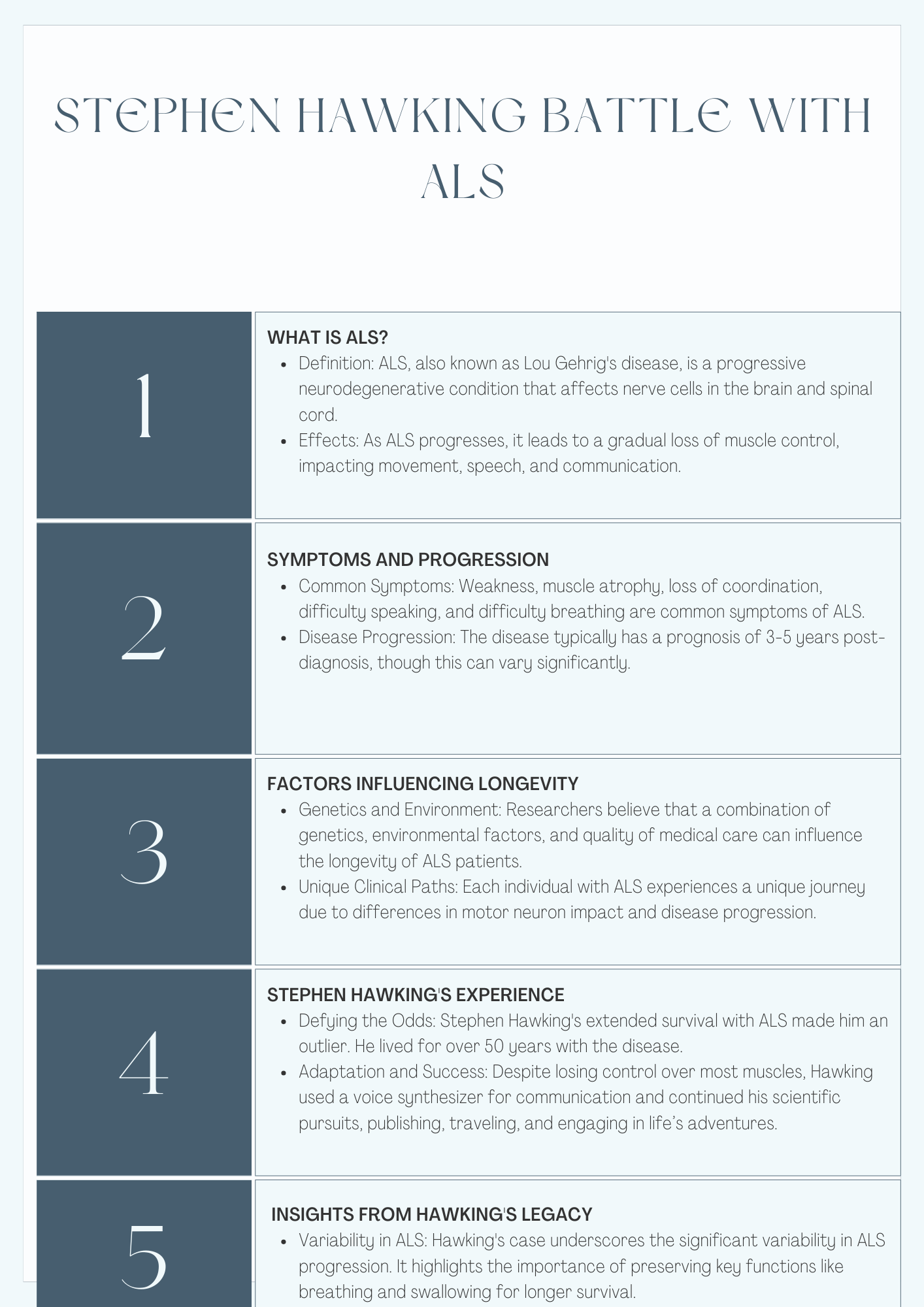Dr. Stephen Hawking, born in England in 1942, led a substantial portion of his life free from disability. He pursued studies in mathematics and physics, culminating in the attainment of a PhD in physics.

PHOTO Courtesy | Getty Images
While pursuing his graduate studies, at the age of 21, Dr. Hawking received a diagnosis of Amyotrophic Lateral Sclerosis (ALS), commonly known as Lou Gehrig’s disease in the U.S. ALS progressively impacts motor neuron function in the brain, disrupting communication with muscles throughout the body.
Consequently, muscle atrophy and loss of voluntary muscle control occur.
Despite the physical challenges posed by ALS, individuals typically retain their intelligence, memory, and personality, even in advanced stages of the disease.
Dr. Hawking assumed a professorship at the University of Cambridge in England.
Throughout his life, he authored numerous articles and several books on theoretical physics and the Big Bang theory. Among his most renowned works is the widely acclaimed book “A Brief History of Time,” published in 1988.
What is ALS
According to the ALS Association, amyotrophic lateral sclerosis (ALS), also known as Lou Gehrig’s disease, is a progressive neurodegenerative condition that impacts nerve cells in the brain and spinal cord.
As the disease progresses, individuals gradually lose their ability to move and communicate due to its effects on nerves and muscle function.
ALS typically manifests between the ages of 40 and 70, with approximately 20,000 Americans affected at any given time, as reported by the ALS Association.
Although the prognosis for ALS patients is generally 3-5 years post-diagnosis, some individuals may live longer, states the association.
Stephen Hawking, who lived with ALS for many decades, defied the typical prognosis associated with the disease.
How uncommon is Hawking’s extended lifespan?
According to the ALS Association, only 5% of ALS patients live beyond 20 years, making Hawking’s longevity quite rare.
Surviving for 50 years or more is virtually unheard of, although Steven Wells, a Canadian, has lived with the condition for nearly 40 years, making him North America’s longest-living ALS patient.
“This is fairly atypical,” says Lucie Bruijn, the ALS Association’s chief scientist, noting that she is unaware of anyone who has survived ALS longer than Hawking.
Additionally, Hawking managed to avoid the dementia that some ALS patients experience in the later stages of the disease, she adds.
Factors that Enabled Hawking to Live Long
Bruijn states that researchers lack certainty regarding how Hawking managed to live with ALS for such an extended period. “ALS is a complex disorder, and each individual’s journey varies greatly,” she explains.
Collaborating with global teams on extensive data initiatives, they strive to comprehend the unique clinical paths, genetic profiles, and environmental exposures of each person affected.
Due to the limited number of cases demonstrating extreme longevity, Bruijn suggests that drawing definitive conclusions about the factors contributing to individuals like Hawking and Wells living longer is challenging.
However, she speculates that a combination of genetics, environment, and medical care likely plays a role.
Bruijn highlights the importance of the type of motor neurons affected by the disease, noting that those controlling eye movement often withstand ALS longer than those in the brain and spinal cord.
Investigating why these cells resist degeneration may offer insights into long-term survival.
Bruijn poses questions about the distinctions between these motor neurons and those in the spinal cord and brain, emphasizing the need for further research to uncover clues.
Insights Gained from Hawking Case
This individual’s experience underscores the remarkable variability inherent in this disorder. While the average life expectancy post-diagnosis is typically two to three years, it’s crucial to recognize that a significant portion of individuals live longer, some considerably so.
Survival hinges on two primary factors: the integrity of the motor neurons governing the diaphragm, essential for breathing, and the deterioration of swallowing muscles, which can result in malnutrition and dehydration.
If these critical functions remain intact, individuals may potentially endure for an extended period despite the progression of the disease.
The extraordinary longevity observed in his case is truly remarkable, positioning him as an exceptional outlier within the ALS spectrum.
Hawking Determination and Success
The disease’s progression impacted most of his muscles, necessitating communication via a voice synthesizer.
Throughout life, he wielded control solely over his eyes and fingers, steering his wheelchair.
Despite confinement to a wheelchair, he fully embraced life, rejecting physical constraints. Celebrating his 60th birthday with a hot-air balloon journey and at 65, engaging in zero-gravity flight, exemplified his adventurous spirit.
His scientific commitments spanned continents, including Antarctica, despite being married twice and fathering three children. Racing his wheelchair in Cambridge, he once incurred a bone-breaking accident.
He cameoed in TV series like Star Trek: The Next Generation and The Big Bang Theory, besides The Simpsons.
The series Stephen Hawking’s Universe elucidated fundamental concepts such as the Big Bang, dark matter, and black holes. His life story unfolded in the acclaimed film The Theory of Everything (2014).
Stephen Hawking delved into profound questions about the universe’s essence, probing our existence and origins.
His inquiries drove pioneering scientific strides, especially in understanding black holes based on Einstein’s General Theory of Relativity.
Collaborating with Roger Penrose, he unveiled the universe’s finite nature, suggesting space-time’s genesis and eventual black hole evaporation.
ALSO READ
Randy Travis Battle with Numerous Diseases: A Look into the Musician’s Health
